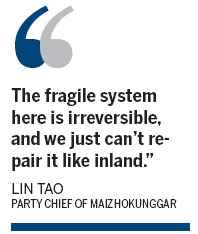'New model' takes account of residents' interests
Updated: 2013-02-18 08:04
By Wang Huazhong and Da Qiong in Maizhokunggar, Tibet (China Daily)
|
||||||||

In a decade, mining has transformed Maizhokunggar from one of the poorest counties in Tibet to one of its largest tax contributors, sparking new thinking among leaders in the autonomous region.
"We can't follow the old ways that we adapted inland," said Lin Tao, the county's Party chief.
Lin is one of the officials from Nanjing, Jiangsu province, sent to Tibet to help build the autonomous region.
"The fragile system here is irreversible, and we just can't repair it like inland."
What Lin practices is "a new model of mining" that compensates locals over the long term and rules that no project may harm the environment.
Maizhokunggar, in central Tibet, sits 4,000 meters above sea level and has frost damage in spring and autumn, storm rain, hail, and drought in summer and dusty winters.
It generated only 5 million yuan ($800,000) in tax revenue in 2003, according to local government sources. But it was the largest county-level contributor (216 million yuan) in 2011.
Huatailong Mining Development Co, a subsidiary of China National Gold Group Corp, which began Phase I production in July 2010, contributed 104 million yuan in tax revenue in 2011 and 121 million yuan in 2012.
The company is investing another 5 billion yuan for the Phase II mining project - following 3.5 billion yuan in Phase I investment.
Lin said the surge of the county government's finances has enabled it to subsidize residents in ways other counties cannot - from providing free meals for all pregnant women and free hospital care up to two weeks before their due date to covering 800 students' tuition fees in college and in addition to a 300 yuan monthly allowance.
However, the county is not alone in benefiting from the natural reserves in Tibet.
According to Tibet's land and resources authority, more than 100 kinds of abundant reserves - including copper, gold, boron and chromium - have been detected in the region. Official estimates put the total value of the reserves at more than 600 billion yuan.
"We're able to push through (the mining project), but we won't do that. That only brings tension and conflict," Lin said on how the leadership of Maizhokunggar developed its ideology on mining.
"It's easy for the government to urge corporations to put in investment, as they promised for production and environmental protection. But the most difficult part is to win residents' support."
Lin added the key is first to stick to the principle that the environment and stability should not be undermined by any project, and second to implement a system that benefits residents and offers long-term compensation instead of a one-time payment.
"The environment must come first," Lin said.
Liu Lijuan, deputy director of Maizhokunggar environmental protection bureau, said the county has consolidated its mining industry and halved the number of mining companies to 10 over the years. It eliminated smaller ones that were unwilling or unable to shoulder social responsibilities.
Wangchug, 51, from Longda village, said the moves had "changed my village", which used to have three mines.
"It was a complete mess and awful when private owners were mining. When they stopped mining in winter, wind blew dried mine tailing and no one could see anything," he said.
Ngawang Tsering, 60, said he no longer worries about environmental deterioration.
He said the area is cleaner since Huatailong's arrival and 2,000 trees the company transplanted from Northeast China to the mining area have survived the harsh conditions.
Liu said the environmental protection bureau has also hired 10 environment monitors to watch sensitive processes of three major mining areas in the county since 2007.
"We don't want others to think of Maizhokunggar as a major mining county, we want them think it a major eco-county," Liu said.
Lin said his government also dedicated to "think on behalf of residents" when helping them to enjoy gain of the development brought by mining.
The government made a policy allowing locals to lease their grassland, rather than sell it, to the mining companies, to benefit generations to come.
Moreover, it distributes cattle dung (traditional fuel) subsidies and "ghee subsidies" to families as the "mining activities changed locals' ways of lives", according to Lin.
Huatailong Mining also established a transport company and distributed 49 percent of the affiliate companies' shares freely to 600 households in Jiama village, where the mines are located. The company employs 57 herdsman and generated 2.65 million yuan in profits.
Lin said the key is to bind locals' interests with those of the company.
"We have built up locals' primary trust in mining. But this is just a beginning and should be continued for a long time," he said. "So long as the government sincerely works for locals and communicates with them sincerely, it will get locals' understanding and support."
(China Daily 02/18/2013 page7)

 In Photos: 7.0-magnitude quake hits Sichuan
In Photos: 7.0-magnitude quake hits Sichuan
 Li Na on Time cover, makes influential 100 list
Li Na on Time cover, makes influential 100 list
 FBI releases photos of 2 Boston bombings suspects
FBI releases photos of 2 Boston bombings suspects
 World's wackiest hairstyles
World's wackiest hairstyles
 Sandstorms strike Northwest China
Sandstorms strike Northwest China
 Never-seen photos of Madonna on display
Never-seen photos of Madonna on display
 H7N9 outbreak linked to waterfowl migration
H7N9 outbreak linked to waterfowl migration
 Dozens feared dead in Texas plant blast
Dozens feared dead in Texas plant blast
Most Viewed
Editor's Picks

|

|

|

|

|

|
Today's Top News
Live report: 7.0-magnitude quake hits Sichuan, heavy casualties feared
Boston suspect cornered on boat
Cross-talk artist helps to spread the word
'Green' awareness levels drop in Beijing
Palace Museum spruces up
First couple on Time's list of most influential
H7N9 flu transmission studied
Trading channels 'need to broaden'
US Weekly

|

|







